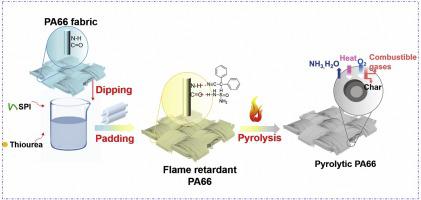当前位置:
X-MOL 学术
›
Prog. Org. Coat.
›
论文详情
Our official English website, www.x-mol.net, welcomes your feedback! (Note: you will need to create a separate account there.)
The fire performance of polyamide66 fabric coated with soybean protein isolation
Progress in Organic Coatings ( IF 6.6 ) Pub Date : 2020-11-01 , DOI: 10.1016/j.porgcoat.2020.105835 Dan Meng , Jia Guo , Aijuan Wang , Xiaoyu Gu , Zhongwei Wang , Shengling Jiang , Sheng Zhang
Progress in Organic Coatings ( IF 6.6 ) Pub Date : 2020-11-01 , DOI: 10.1016/j.porgcoat.2020.105835 Dan Meng , Jia Guo , Aijuan Wang , Xiaoyu Gu , Zhongwei Wang , Shengling Jiang , Sheng Zhang

|
Abstract It has been a big challenge to produce sustainable environmental-friendly flame- retardant synthetic textiles for many years. In this work, soybean protein isolation in association with thiourea was coated on the surface of fibers through a simple pad-dry process in order to prepare flame retardant polyamide 66 (PA66) fabric with reduced environmental hazard and fire risk. The chemical components and the morphology of the treated fabric surface were analyzed by a Fourier transform infrared spectrometer and a scanning electron microscopy respectively. The flammability evaluation by limiting oxygen index (LOI) and vertical burning tests indicated that the LOI value was increased from 20.5–25.5, the damaged char length was reduced to only 4 cm, and the dripping phenomenon was eliminated for the coated PA66 fabric sample by the presence of protein/thiourea. It was demonstrated that the deposited protein/thiourea combination coating significantly improved the fire hazard resistance through affecting the thermal degradation pathway of PA66 fabric. It was proposed that oxygen and flammable gases in the gas phase be diluted by the released H2S, NH3, H2O gases, and compact char formation be promoted by the formed unsaturated double bonds (such as -C = N) during the burning process of PA66-SPI-thiourea samples. It was suggested the sustainable bio-based SPI could be an effective alternative to conventional flame retardants used in textile finishing.
中文翻译:

大豆蛋白隔离涂层聚酰胺66织物的防火性能
摘要 多年来,生产可持续的环保型阻燃合成纺织品一直是一个巨大的挑战。在这项工作中,通过简单的轧干工艺将与硫脲结合的大豆蛋白分离物涂覆在纤维表面,以制备具有降低环境危害和火灾风险的阻燃聚酰胺 66 (PA66) 织物。分别采用傅里叶变换红外光谱仪和扫描电子显微镜分析处理后织物表面的化学成分和形貌。通过极限氧指数(LOI)和垂直燃烧测试的可燃性评估表明,LOI值从20.5增加到25.5,损坏的炭长度减少到只有4厘米,并且通过蛋白质/硫脲的存在消除了涂层PA66织物样品的滴落现象。结果表明,沉积的蛋白质/硫脲复合涂层通过影响PA66织物的热降解途径显着提高了抗火灾危害性。提出气相中的氧气和可燃气体被释放的H2S、NH3、H2O气体稀释,在PA66燃烧过程中形成的不饱和双键(如-C=N)促进了致密炭的形成-SPI-硫脲样品。有人建议,可持续的生物基 SPI 可能是纺织品整理中使用的传统阻燃剂的有效替代品。结果表明,沉积的蛋白质/硫脲复合涂层通过影响PA66织物的热降解途径显着提高了抗火灾危害性。提出气相中的氧气和可燃气体被释放的H2S、NH3、H2O气体稀释,在PA66燃烧过程中形成的不饱和双键(如-C=N)促进了致密炭的形成-SPI-硫脲样品。有人建议,可持续的生物基 SPI 可能是纺织品整理中使用的传统阻燃剂的有效替代品。结果表明,沉积的蛋白质/硫脲复合涂层通过影响PA66织物的热降解途径显着提高了抗火灾危害性。提出气相中的氧气和可燃气体被释放的H2S、NH3、H2O气体稀释,在PA66燃烧过程中形成的不饱和双键(如-C=N)促进了致密炭的形成-SPI-硫脲样品。有人建议,可持续的生物基 SPI 可能是纺织品整理中使用的传统阻燃剂的有效替代品。PA66-SPI-硫脲样品在燃烧过程中形成的不饱和双键(例如-C = N)促进了致密炭的形成。有人建议,可持续的生物基 SPI 可能是纺织品整理中使用的传统阻燃剂的有效替代品。PA66-SPI-硫脲样品在燃烧过程中形成的不饱和双键(例如-C = N)促进了致密炭的形成。有人建议,可持续的生物基 SPI 可能是纺织品整理中使用的传统阻燃剂的有效替代品。
更新日期:2020-11-01
中文翻译:

大豆蛋白隔离涂层聚酰胺66织物的防火性能
摘要 多年来,生产可持续的环保型阻燃合成纺织品一直是一个巨大的挑战。在这项工作中,通过简单的轧干工艺将与硫脲结合的大豆蛋白分离物涂覆在纤维表面,以制备具有降低环境危害和火灾风险的阻燃聚酰胺 66 (PA66) 织物。分别采用傅里叶变换红外光谱仪和扫描电子显微镜分析处理后织物表面的化学成分和形貌。通过极限氧指数(LOI)和垂直燃烧测试的可燃性评估表明,LOI值从20.5增加到25.5,损坏的炭长度减少到只有4厘米,并且通过蛋白质/硫脲的存在消除了涂层PA66织物样品的滴落现象。结果表明,沉积的蛋白质/硫脲复合涂层通过影响PA66织物的热降解途径显着提高了抗火灾危害性。提出气相中的氧气和可燃气体被释放的H2S、NH3、H2O气体稀释,在PA66燃烧过程中形成的不饱和双键(如-C=N)促进了致密炭的形成-SPI-硫脲样品。有人建议,可持续的生物基 SPI 可能是纺织品整理中使用的传统阻燃剂的有效替代品。结果表明,沉积的蛋白质/硫脲复合涂层通过影响PA66织物的热降解途径显着提高了抗火灾危害性。提出气相中的氧气和可燃气体被释放的H2S、NH3、H2O气体稀释,在PA66燃烧过程中形成的不饱和双键(如-C=N)促进了致密炭的形成-SPI-硫脲样品。有人建议,可持续的生物基 SPI 可能是纺织品整理中使用的传统阻燃剂的有效替代品。结果表明,沉积的蛋白质/硫脲复合涂层通过影响PA66织物的热降解途径显着提高了抗火灾危害性。提出气相中的氧气和可燃气体被释放的H2S、NH3、H2O气体稀释,在PA66燃烧过程中形成的不饱和双键(如-C=N)促进了致密炭的形成-SPI-硫脲样品。有人建议,可持续的生物基 SPI 可能是纺织品整理中使用的传统阻燃剂的有效替代品。PA66-SPI-硫脲样品在燃烧过程中形成的不饱和双键(例如-C = N)促进了致密炭的形成。有人建议,可持续的生物基 SPI 可能是纺织品整理中使用的传统阻燃剂的有效替代品。PA66-SPI-硫脲样品在燃烧过程中形成的不饱和双键(例如-C = N)促进了致密炭的形成。有人建议,可持续的生物基 SPI 可能是纺织品整理中使用的传统阻燃剂的有效替代品。


























 京公网安备 11010802027423号
京公网安备 11010802027423号